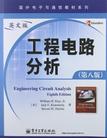工程电路分析
出版时间:2012-6 出版社:电子工业出版社 作者:(美)海特,(美)凯默利,(美)德宾 著 页数:852 字数:1158000
内容概要
本书首版于1962年,目前已是第八版。作者从3个最基本的科学定律推导出电路分析中常用的分析方法及分析工具。书中首先介绍电路基本参量及基本概念,然后结合基尔霍夫电压和电流定律,介绍节点和网孔分析法及叠加定理、电源变换等常用电路分析方法,并将运算放大器作为电路元件加以介绍;交流电路的分析开始于电容、电感的时域电路特性,然后分析RLC电路的正弦稳态响应,并介绍交流电路的功率分析方法,接着还对多相电路、磁耦合电路的性能分析进行了介绍;本书还介绍了复频率、拉普拉斯变换和s域分析、频率响应、傅里叶分析、二端口网络等内容。作者注重将理论和实践相结合,无论例题、练习、章后习题还是正文中的应用实例,很多都来自于业界的典型应用,这也是本书的一大特色。
书籍目录
INTRODUCTION
1.1 Overview of Text
1.2 Relationship of Circuit Analysis to Engineering
1.3 Analysis and Design
1.4 Computer-Aided Analysis
1.5 Successful Problem-Solving Strategies
READING FURTHER
CHAPTER 1 BASIC COMPONENTS AND ELECTRIC CIRCUITS
2.1 Units and Scales
2.2 Charge, Current, Voltage, and Power
2.3 Voltage and Current Sources
2.4 Ohm’s Law
SUMMARYAND REVIEW
READING FURTHER
EXERCISES
CHAPTER 2 VOLTAGE AND CURRENT LAWS
3.1 Nodes, Paths, Loops, and Branches
3.2 Kirchhoff’s Current Law
3.3 Kirchhoff’s Voltage Law
3.4 The Single-Loop Circuit
3.5 The Single-Node-Pair Circuit
3.6 Series and Parallel Connected Sources
3.7 Resistors in Series and Parallel
3.8 Voltage and Current Division
SUMMARYAND REVIEW
READING FURTHER
EXERCISES
CHAPTER 3 BASIC NODAL AND MESH ANALYSIS
4.1 Nodal Analysis
4.2 The Supernode
4.3 Mesh Analysis
4.4 The Supermesh
4.5 Nodal vs. Mesh Analysis: A Comparison
4.6 Computer-Aided Circuit Analysis SUMMARY AND REVIEW READING
FURTHER EXERCISES
CHAPTER 4 HANDY CIRCUIT ANALYSIS TECHNIQUES
5.1 Linearity and Superposition
5.2 Source Transformations
5.3 Thévenin and Norton Equivalent Circuits
5.4 Maximum Power Transfer
5.5 Delta-Wye Conversion
5.6 Selecting an Approach: A Summary of Various Techniques
CHAPTER 5 THE OPERATIONAL
6.1 Background
6.2 The Ideal Op Amp:
6.3 Cascaded Stages
6.4 Circuits for Voltage
6.5 Practical Considerations
6.6 Comparators and
CHAPTER 6 CAPACITORS AND
7.1 The Capacitor
7.2 The Inductor
7.3 Inductance and
7.4 Consequences
7.5 Simple Op Amp
7.6 Duality
7.7 Modeling Capacitors and Inductors with PSpice
CHAPTER 7
BASIC RL AND RC CIRCUITS
8.1 The Source-Free RL Circuit
8.2 Properties of the Exponential Response
8.3 The Source-Free RC Circuit
8.4 A More General Perspective
8.5 The Unit-Step Function
8.6 Driven RL Circuits
8.7 Natural and Forced Response
8.8 Driven RC Circuits
8.9 Predicting the Response of Sequentially Switched Circuits
CHAPTER 8
THE RLC CIRCUIT 1
9.1 The Source-Free Parallel Circuit 1
9.2 The Overdamped Parallel RLC Circuit
9.3 Critical Damping
9.4 The Underdamped Parallel RLC Circuit
9.5 The Source-Free Series RLC Circuit
9.6 The Complete Response of the RLC Circuit
9.7 The Lossless LC Circuit
CHAPTER 9 SUMMARY AND REVIEW READING FURTHER EXERCISES SINUSOIDAL
STEADY-STATE ANALYSIS
10.1 Characteristics of Sinusoids
10.2 Forced Response to Sinusoidal Functions
10.3 The Complex Forcing Function
10.4 The Phasor
10.5 Impedance and Admittance
10.6 Nodal and Mesh Analysis
10.7 Superposition, Source Transformations and Thévenin’s
Theorem
10.8 Phasor Diagrams
CHAPTER 10 AC CIRCUIT POWER ANALYSIS
11.1 Instantaneous Power
11.2 Average Power
11.3 Effective Values of Current and Voltage
11.4 Apparent Power and Power Factor
11.5 Complex Power
CHAPTER 11 POLYPHASE CIRCUITS
12.1 Polyphase Systems
12.2 Single-Phase Three-Wire Systems
12.3 Three-Phase Y-Y Connection
12.4 The Delta (_) Connection
12.5 Power Measurement in Three-Phase Systems
CHAPTER 12 MAGNETICALLY COUPLED CIRCUITS
13.1 Mutual Inductance
13.2 Energy Considerations
13.3 The Linear Transformer
13.4 The Ideal Transformer
CHAPTER 13 COMPLEX FREQUENCY AND THE LAPLACE TRANSFORM 3
14.1 Complex Frequency 3
14.2 The Damped Sinusoidal Forcing Function
14.3 Definition of the
章节摘录
Voltage We must now begin to refer to a circuit element, something best defined in general terms to begin with.Such electrical devices as fuses, light bulbs, re-sistors, batteries, capacitors, generators, and spark coils can be represented by combinations of simple circuit elements.We begin by showing a very general circuit element as a shapeless object possessing two terminals at which connections to other elements may be made (Fig.2.8).There are two paths by which current may enter or leave the element.In subsequent discussions we will define particular circuit elements by describ-ing the electrical characteristics that may be observed at their terminals.In Fig.2.8, let us suppose that a dc current is sent into terminal A,through the general element, and back out of terminal B.Let us also assume that pushing charge through the element requires an expenditure of energy.We then say that an electrical voltage (or a potential difference) exists be-tween the two terminals, or that there is a voltage "across" the element.Thus, the voltage across a terminal pair is a measure of the work required to move charge through the element.The unit of voltage is the volt,2 and 1 volt is the same as 1 J/C.Voltage is represented by V or v.A voltage can exist between a pair of electrical terminals whether a current is flowing or not.An automobile battery, for example, has a voltage of 12 V across its terminals even if nothing whatsoever is connected to the terminals.According to the principle of conservation of energy, the energy that is expended in forcing charge through the element must appear somewhere else.When we later meet specific circuit elements, we will note whether that energy is stored in some form that is readily available as electric energy or whether it changes irreversibly into heat, acoustic energy, or some other nonelectrical form.We must now establish a convention by which we can distinguish be-tween energy supplied to an element and energy that is supplied by the element itself.We do this by our choice of sign for the voltage of terminalA with respect to terminal B.If a positive current is entering terminal A of the element and an external source must expend energy to establish this cur-rent, then terminal A is positive with respect to terminal B.(Alternatively,we may say that terminal B is negative with respect to terminal A.)
图书封面
评论、评分、阅读与下载
用户评论 (总计2条)
- 非常不错的书!不过有一点我不明白为什么有两章没有纸质版的只有电子版?难道就为了省那么一点钱?
- 很注重基础的一本书,看原版也能很好地锻炼英语阅读能力。
